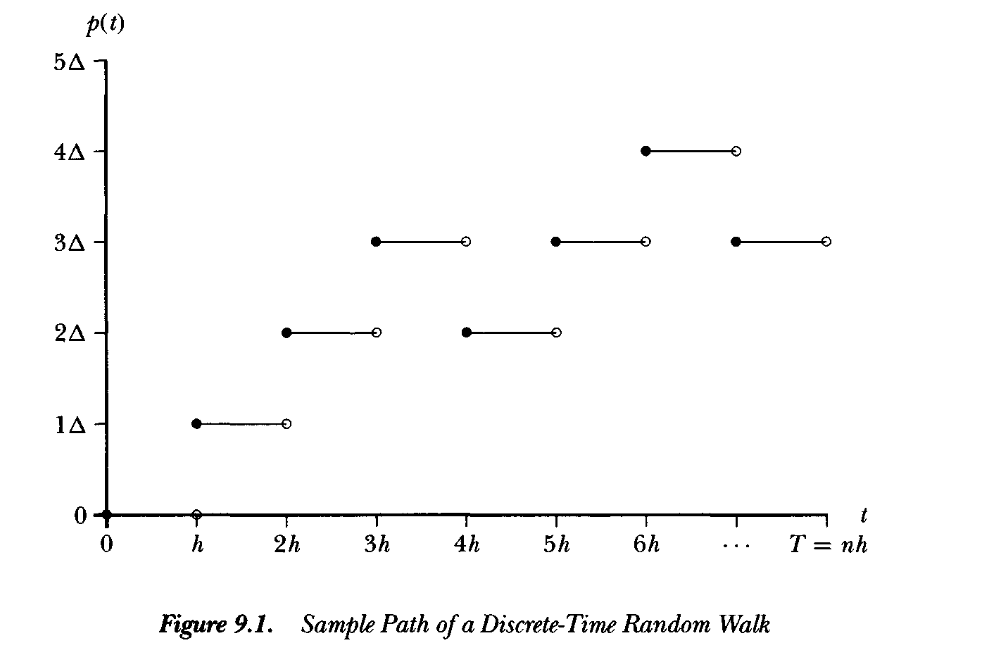Brownian Motion is the pattern for measuring the convergence of random walk through continuous timing.
discrete random walk
discrete random walk is a tool used to construct Brownian Motion. It is a random walk which only takes on two discrete values at any given time: \(\Delta\) and its additive inverse \(-\Delta\). These two cases take place at probabilities \(\pi\) and \(1-\pi\).
Therefore, the expected return over each time \(k\) is:
\begin{equation} \epsilon_{k} = \begin{cases} \Delta, p(\pi) \\ -\Delta, p(1-\pi) \end{cases} \end{equation}
(that, at any given time, the expectation of return is either—with probability $π$—\(\Delta\), or–with probability $1-π$—\(-\Delta\).
This makes \(\epsilon_{k}\) independently and identically distributed. The price, then, is formed by:
\begin{equation} p_{k} = p_{k-1}+\epsilon_{k} \end{equation}
and therefore the price follows a random walk.
Such a discrete random walk can look like this:

We can split this time from \([0,T]\) into \(n\) pieces; making each segment with length \(h=\frac{T}{n}\). Then, we can parcel out:
\begin{equation} p_{n}(t) = p_{[\frac{t}{h}]} = p_{[\frac{nt}{T}]} \end{equation}
Descretized at integer intervals.
At this current, discrete moments have expected value \(E[p_{n}(T)] = n(\pi -(1-\pi))\Delta\) and variance \(Var[p_{n}(T)]=4n\pi (1-\pi)\Delta^{2}\). #why
Now, if we want to have a continuous version of the descretized interval above, we will maintain the finiteness of \(p_{n}(T)\) but take \(n\) to \(\infty\). To get a continuous random walk needed for Brownian Motion, we adjust \(\Delta\), \(\pi\), and \(1-\pi\) such that the expected value and variance tends towards the normal (as we expect for a random walk); that is, we hope to see that:
\begin{equation} \begin{cases} n(\pi -(1-\pi))\Delta \to \mu T \\ 4n\pi (1-\pi )\Delta ^{2} \to \sigma^{2} T \end{cases} \end{equation}
To solve for these desired convergences into the normal, we have probabilities \(\pi, (1-\pi), \Delta\) such that:
\begin{equation} \begin{cases} \pi = \frac{1}{2}\qty(1+\frac{\mu \sqrt{h}}{\sigma})\\ (1-\pi) = \frac{1}{2}\qty(1-\frac{\mu \sqrt{h}}{\sigma})\\ \Delta = \sigma \sqrt{h} \end{cases} \end{equation}
where, \(h = \frac{1}{n}\).
So looking at the expression for \(\Delta\), we can see that as \(n\) in increases, \(h =\frac{1}{n}\) decreases and therefore \(\Delta\) decreases. In fact, we can see that the change in all three variables track the change in the rate of \(\sqrt{h}\); namely, they vary with O(h).
\begin{equation} \pi = (1-\pi) = \frac{1}{2}+\frac{\mu \sqrt{h}}{2\sigma} = \frac{1}{2}+O\qty(\sqrt{h}) \end{equation}
Of course:
\begin{equation} \Delta = O\qty(\sqrt{h}) \end{equation}
So, finally, we have the conclusion that:
- as \(n\) (number of subdivision pieces of the time domain \(T\)) increases, \(\frac{1}{n}\) decreases, \(O\qty(\sqrt{h})\) decreases with the same proportion. Therefore, as \(\lim_{n \to \infty}\) in the continuous-time case, the probability of either positive or negative delta (\(\pi\) and \(-\pi\) trends towards each to \(\frac{1}{2}\))
- by the same vein, as \(\lim_{n \to \infty}\), \(\Delta \to 0\)
Therefore, this is a cool result: in a continuous-time case of a discrete random walk, the returns (NOT! just the expect value, but literal \(\Delta\)) trend towards \(+0\) and \(-0\) each with \(\frac{1}{2}\) probability.
actual Brownian motion
Given the final results above for the limits of discrete random walk, we can see that the price moment traced from the returns (i.e. \(p_{k} = p_{k-1}+\epsilon_{k}\)) have the properties of normality (\(p_{n}(T) \to \mathcal{N}(\mu T, \sigma^{2}T)\))
True Brownian Motion follows, therefore, three basic properties:
- \(B_{t}\) is normally distributed by a mean of \(0\), and variance of \(t\)
- For some \(s<t\), \(B_{t}-B_{s}\) is normally distributed by a mean of \(0\), and variance of \(t-s\)
- Distributions \(B_{j}\) and \(B_{t}-B_{s}\) is independent
Standard Brownian Motion
Brownian motion that starts at \(B_0=0\) is called Standard Brownian Motion
quadratic variation
The quadratic variation of a sequence of values is the expression that:
\begin{equation} \sum_{i=0}^{N-1} (x_{i+1}-x_i)^{2} \end{equation}
On any sequence of values \(x_0=0,\dots,x_{N}=1\) (with defined bounds), the quadratic variation becomes bounded.